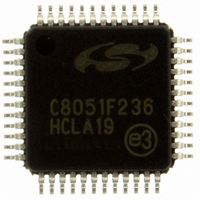C8051F236-GQ Silicon Laboratories Inc, C8051F236-GQ Datasheet - Page 121

C8051F236-GQ
Manufacturer Part Number
C8051F236-GQ
Description
IC 8051 MCU 8K FLASH 48TQFP
Manufacturer
Silicon Laboratories Inc
Series
C8051F2xxr
Specifications of C8051F236-GQ
Program Memory Type
FLASH
Program Memory Size
8KB (8K x 8)
Package / Case
48-TQFP, 48-VQFP
Core Processor
8051
Core Size
8-Bit
Speed
25MHz
Connectivity
SPI, UART/USART
Peripherals
Brown-out Detect/Reset, POR, WDT
Number Of I /o
32
Ram Size
1.25K x 8
Voltage - Supply (vcc/vdd)
2.7 V ~ 3.6 V
Oscillator Type
Internal
Operating Temperature
-40°C ~ 85°C
Processor Series
C8051F2x
Core
8051
Data Bus Width
8 bit
Data Ram Size
1.25 KB
Interface Type
SPI/UART
Maximum Clock Frequency
25 MHz
Number Of Programmable I/os
32
Number Of Timers
3
Operating Supply Voltage
2.7 V to 3.6 V
Maximum Operating Temperature
+ 85 C
Mounting Style
SMD/SMT
3rd Party Development Tools
PK51, CA51, A51, ULINK2
Development Tools By Supplier
C8051F226DK
Minimum Operating Temperature
- 40 C
On-chip Adc
8 bit, 32 Channel
Lead Free Status / RoHS Status
Lead free / RoHS Compliant
Eeprom Size
-
Data Converters
-
Lead Free Status / Rohs Status
Lead free / RoHS Compliant
Other names
336-1244
Available stocks
Company
Part Number
Manufacturer
Quantity
Price
Company:
Part Number:
C8051F236-GQ
Manufacturer:
Silicon Laboratories Inc
Quantity:
10 000
Company:
Part Number:
C8051F236-GQR
Manufacturer:
MICROCHIP
Quantity:
2 500
Company:
Part Number:
C8051F236-GQR
Manufacturer:
Silicon Laboratories Inc
Quantity:
10 000
C8051F2xx
16.1.3. Mode 2: 9-Bit UART, Fixed Baud Rate
Mode 2 provides asynchronous, full-duplex communication using a total of eleven bits per data byte: a start
bit, 8 data bits (LSB first), a programmable ninth data bit, and a stop bit (see timing diagram in
Figure 16.6). On transmit, the ninth data bit is determined by the value in TB8 (SCON.3). It can be
assigned the value of the parity flag P in the PSW or used in multiprocessor communications. On receive,
the ninth data bit goes into RB8 (SCON.2) and the stop bit is ignored.
Data transmission begins when an instruction writes a data byte to the SBUF register. The TI Transmit
Interrupt Flag (SCON.1) is set at the end of the transmission (the beginning of the stop-bit time). Data
reception can begin any time after the REN Receive Enable bit (SCON.4) is set to logic 1. After the stop bit
is received, the data byte will be loaded into the SBUF receive register if the following conditions are met:
RI must be logic 0, and if SM2 is logic 1, the 9th bit must be logic 1.
If these conditions are met, the eight bits of data is stored in SBUF, the ninth bit is stored in RB8 and the RI
flag is set. If these conditions are not met, SBUF and RB8 will not be loaded and the RI flag will not be set.
An interrupt will occur if enabled when either TI or RI are set.
The baud rate in Mode 2 is a direct function of the system clock frequency as follows:
Mode 2 Baud Rate = 2SMOD x (SYSCLK / 64).
The SMOD bit (PCON.7) selects whether to divide SYSCLK by 32 or 64. In the formula, 2 is raised to the
power SMOD, resulting in a baud rate of either 1/32 or 1/64 of the system clock frequency. On reset, the
SMOD bit is logic 0, thus selecting the lower speed baud rate by default.
MARK
START
STOP
D0
D1
D2
D3
D4
D5
D6
D7
D8
BIT
BIT
SPACE
BIT TIMES
BIT SAMPLING
Figure 16.6. UART Modes 2 and 3 Timing Diagram
16.1.4. Mode 3: 9-Bit UART, Variable Baud Rate
Mode 3 is the same as Mode 2 in all respects except the baud rate is variable. The baud rate is deter-
mined in the same manner as for Mode 1. Mode 3 operation transmits 11 bits: a start bit, 8 data bits (LSB
first), a programmable ninth data bit, and a stop bit. Timer 1 or Timer 2 overflows generate the baud rate
just as with Mode 1. In summary, Mode 3 transmits using the same protocol as Mode 2 but with Mode 1
baud rate generation.
Rev. 1.6
121











